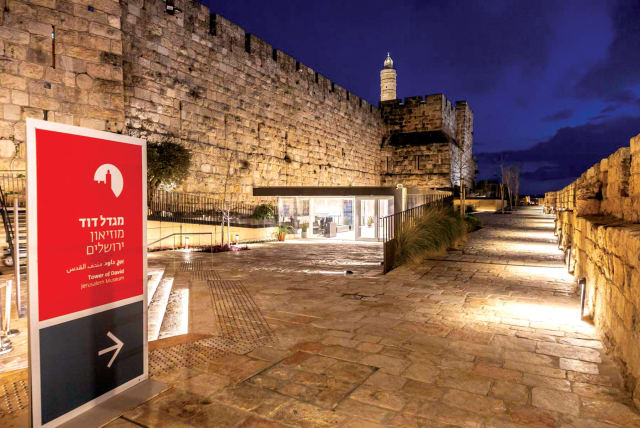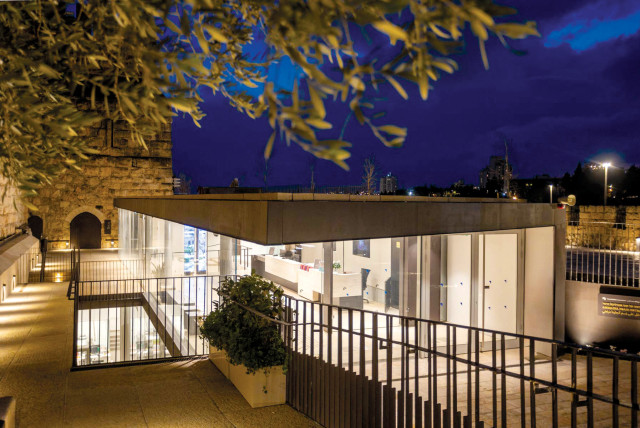Tower of David Jerusalem opens multi-level pavilion

After more than a decade of planning and three years of construction, the final part of the renewal of the Tower of David Jerusalem Museum is complete.
Ten steps inside the Old City of Jerusalem at the Jaffa Gate lie two tombs. Legend has it that they are the tombs of two Ottoman engineers, beheaded and buried by Suleiman the Magnificent in the 16th century. Some say that they lie there in everlasting disgrace for not including David’s Tomb on Mount Zion inside the Old City walls. On the contrary, some say that they lie there, as sultan Suleiman was so impressed with their work that he did not want any other city to be as beautiful as Jerusalem and therefore killed his engineers to stop them from taking their talents elsewhere. Whichever legend one chooses to believe, for those who worked on the new entrance pavilion at the Tower of David Jerusalem Museum, the tombs were a constant reminder of the high stakes at play when building in the Old City!
After more than a decade of planning and three years of construction, with a multi-disciplinary team of archaeologists, architects, curators, researchers, and designers, the final part of the renewal of the Tower of David Jerusalem Museum is complete. Nestled between the walls of Jerusalem’s Old City and the citadel walls that have guarded Jerusalem for hundreds of years, the Angelina Drahi Entrance Pavilion is the newest architectural layer to Jerusalem’s Old City. Building regulations in the city forbid building above the height of the Old City walls. As a result, 17 meters were excavated down in which to build a multi-level pavilion that now houses the ticket office of the museum, a changing exhibition gallery, and a labyrinth of offices for the Education Center. Outside there is shaded seating area, and in May the coffee shop will open.
Making additional space at the Tower of David
“For years we wondered how we could create additional space in the Tower of David complex – a national heritage site of archaeological and historical importance,” says Eilat Lieber, director and chief curator of the museum. “It seemed an impossible task; but with a creative team, we now have an additional 1,000 square meters to be used in multiple ways for the museum.”
Under the inspired direction of Kimmel Eshkolot Architects, Prof. Etan Kimmel, and architect Yotam Cohen-Sagi, the ancient citadel was transformed into a welcoming and accessible environment, ready to house a modern museum and everything that entailed with new additional spaces.
“The opportunity to bring the 21st century to this ancient iconic site is both a responsibility and an honor. We were set the task of renovating one of the earliest and most important architectural treasures of Jerusalem,” says Kimmel, co-founder of Kimmel Eshkolot Architects. “Our challenge boiled down to our ability to find solutions to preserve the ancient stones which represent Jerusalem’s past without compromising their historic value or their beauty, all the while planning new architectural structures and introducing modern infrastructure using modern materials to create a fruitful, interesting meeting between the new and the old. Ever-present in our planning was our respect for this ancient structure.”
As with all construction in Jerusalem, the Israel Antiquities Authority first carried out an excavation of the site.
Cohen-Sagi, lead architect of Kimmel Eshkolot Architects, jokes, “You only need to use a teaspoon to dig up antiquities in the Old City of Jerusalem, and this is even more true when you are building a structure underground next to a citadel thousands of years old.”
In order to minimize the lack of uncertainty ahead of the build, the team used a range of resources at their disposal – from core sampling to exploratory archaeological excavations, as well documented material from the beginning of the 20th century by British archaeologist Cedric Norman Johns. However, the surprise in the excavation came not from what they discovered during the excavations but from what the team discovered was missing, namely the foundations to part of the citadel and the Old City walls. Just months into building, the plans had to be changed, and reinforcements to the citadel walls were created.
“For two months, we dug 80 piles into the ground,” recounts Lieber. “This was a new engineering plan because once we realized that part of the citadel walls was not sitting on any foundations, we needed to come up with a different solution and proposal. This was probably the most stressful time of the whole renewal. I used to worry, thinking ‘What if the walls of the Old City fell down on my watch!’ she says, shuddering slightly as she recalls the early days of the project.
Sagi-Cohen considers the entrance pavilion as their most significant architectural combination, as the modern building is built submerged into the stone outer courtyard of the citadel. The new building, funded by the Lina and Patrick Drahi Foundation, is a sleek, elegant glass structure that allows direct entrance from the Jaffa Gate and the Mamilla Mall to the new Tower of David Jerusalem Museum. The strategic move to build the new entrance pavilion on the western side of the citadel at the Jaffa Gate harnessed the energy of the growing Jerusalem metropolis. The Jaffa Gate has been the main entrance to the Old City for hundreds of years. In the last 20 years, however, there have been modern infrastructure added by the municipality allowing for easy access from the light rail and for parking close by. The new pavilion allows for a change in the circulation to the historic site. It is situated at the lowest topographical point around the citadel and thus allows visitors who pass through the building to enter the citadel, a continually upward journey through the new galleries and conserved open passageways, ending at the top of the observation point overlooking the whole of Jerusalem from the rooftop of the Phasael Tower, 30 meters above the new entrance pavilion, 777 meters above sea level. Lieber has future plans for the pavilion and hopes that the structure will join the adjacent Byzantine Jerusalem excavations under the Jaffa Gate Plaza via an accessible underground tunnel. The preparations are already in place.
The $50 million renewal and conservation of the Tower of David Jerusalem Museum was led by Dame Vivien Duffield through the Clore Israel Foundation. Now the museum has a permanent exhibition that focuses on the events and developments that have shaped the city over 4,000 years and continue to influence its present-day identity as the capital of the State of Israel. Through ancient authentic artifacts, as well as the latest in multi-media technology, film and animation with interactive touch screens, video mapping and immersive video installations, the museum’s new permanent exhibition also explores the historical narrative of Jerusalem with its significance to Judaism, Christianity, and Islam.
Moshe Lion, the mayor of Jerusalem, says, “Jerusalem is like no other city, and the Tower of David Jerusalem Museum is like no other city museum. The ancient citadel has been the symbol of the city through the ages and one of the most important historic and archaeological heritage sites in the world. The new Tower of David Jerusalem Museum at the Jaffa Gate will serve as the new gateway to Jerusalem for the millions of visitors, tourists, and pilgrims who will be able to explore the city’s rich and complex history before visiting the religious sites and ancient alleyways of the Old City.”
For now, the museum is mainly welcoming Israelis through its new entrance pavilion. Half of those visiting are displaced residents from the country’s North and South. The opening of the new entrance pavilion was postponed from November 2023 due to the war. On March 7, the new entrance pavilion will hold its inaugural exhibition titled “The Jerusalem School,” which pays homage to the historical Tower of David Museum that opened its gates during the British Mandate period and showcased the artists from that time on the grounds of the citadel. The exhibition will show a retrospective of art in Jerusalem from the beginning of the 20th century until the 1950s. The exhibition at the Tower of David is being done in conjunction with an exhibition being curated at HaMiffal that examines art in Jerusalem from 1950 until the present day.■
Jerusalem Post Store
`; document.getElementById("linkPremium").innerHTML = cont; var divWithLink = document.getElementById("premium-link"); if (divWithLink !== null && divWithLink !== 'undefined') { divWithLink.style.border = "solid 1px #cb0f3e"; divWithLink.style.textAlign = "center"; divWithLink.style.marginBottom = "15px"; divWithLink.style.marginTop = "15px"; divWithLink.style.width = "100%"; divWithLink.style.backgroundColor = "#122952"; divWithLink.style.color = "#ffffff"; divWithLink.style.lineHeight = "1.5"; } } (function (v, i) { });

